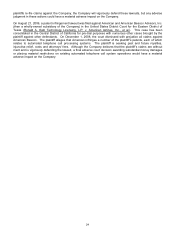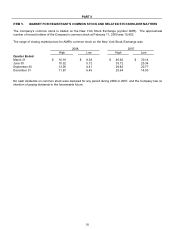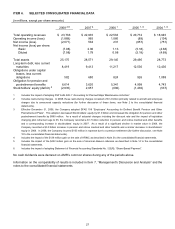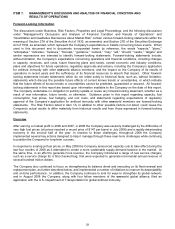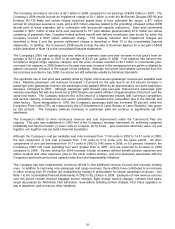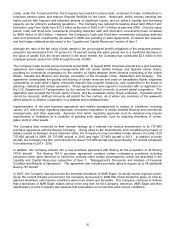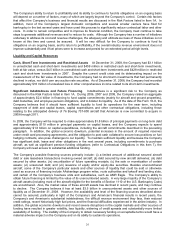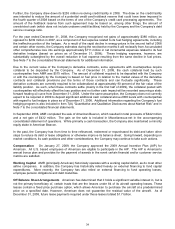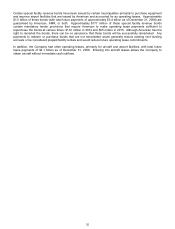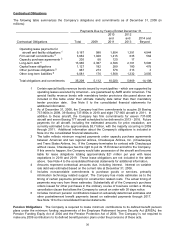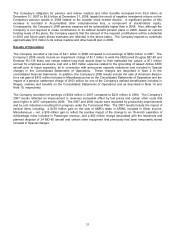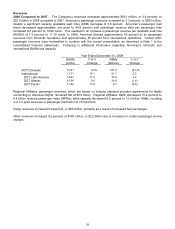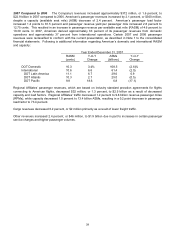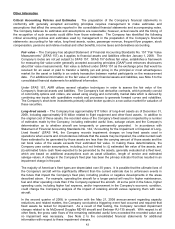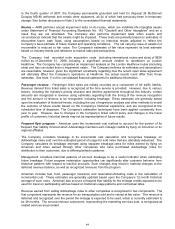American Airlines 2008 Annual Report Download - page 37
Download and view the complete annual report
Please find page 37 of the 2008 American Airlines annual report below. You can navigate through the pages in the report by either clicking on the pages listed below, or by using the keyword search tool below to find specific information within the annual report.34
Further, the Company drew down its $255 million revolving credit facility in 2008. The draw on the credit facility
was intended to reduce the amount of a potential credit card holdback reserve that could have been imposed in
the fourth quarter of 2008 based on the terms of one of the Company’s credit card processing agreements. The
amount of the holdback reserve from such agreement may be based on, among other things, the amount of
unrestricted cash (which does not include undrawn credit facilities) held by the Company and the Company’s debt
service coverage ratio.
For the year ended December 31, 2008, the Company recognized net gains of approximately $380 million, as
opposed to $239 million in 2007, as a component of fuel expense related to its fuel hedging agreements, including
the ineffective portion of the hedges. As a result of the rapid decline in energy prices in the second half of 2008
and certain other events, the Company estimates during the next twelve months it will reclassify from Accumulated
other comprehensive loss into earnings approximately $711 million in net incremental expenses related to its fuel
derivative hedges (based on prices as of December 31, 2008). These hedging expenses, however, are
substantially outweighed by the overall reduction in fuel expense resulting from the same decline in fuel prices.
See Note 7 to the consolidated financial statements for additional information.
Due to the current value of the Company’s derivative contracts, some agreements with counterparties require
collateral to be deposited by the Company. As of December 31, 2008, the cash collateral held by such
counterparties from AMR was $575 million. The amount of collateral required to be deposited with the Company
or with the counterparty by the Company is based on fuel price in relation to the market values of the derivative
contracts and collateral provisions per the terms of those contracts and can fluctuate significantly. These
derivative contracts are currently required to be collateralized at approximately 90 percent of the fair value of the
liability position. As such, when these contracts settle (mainly in the first half of 2009), the collateral posted with
counterparties will effectively offset the loss position and no further cash impact will be recorded assuming a static
forward heating oil curve from December 31, 2008. Under the same assumption, the Company does not currently
expect to be required in 2009 to deposit significant additional cash collateral above 2008 levels with counterparties
with regard to fuel hedges in place as of December 31, 2008. Additional information regarding the Company’s fuel
hedging program is also included in Item 7(A) “Quantitative and Qualitative Disclosures about Market Risk” and in
Note 7 to the consolidated financial statements.
In September 2008, AMR completed the sale of American Beacon, which resulted in total proceeds of $442 million
and a net gain of $432 million. The gain on the sale is included in Miscellaneous-net in the accompanying
consolidated statement of operations. While primarily a cash transaction, the Company also maintained a minority
equity stake in American Beacon.
In the past, the Company has from time to time refinanced, redeemed or repurchased its debt and taken other
steps to reduce its debt or lease obligations or otherwise improve its balance sheet. Going forward, depending on
market conditions, its cash positions and other considerations, the Company may continue to take such actions.
Compensation On January 27, 2009, the Company approved the 2009 Annual Incentive Plan (AIP) for
American. All U.S. based employees of American are eligible to participate in the AIP. The AIP is American's
annual bonus plan and provides for the payment of awards in the event certain financial and/or customer service
metrics are satisfied.
Working Capital AMR (principally American) historically operates with a working capital deficit, as do most other
airline companies. In addition, the Company has historically relied heavily on external financing to fund capital
expenditures. More recently, the Company has also relied on external financing to fund operating losses,
employee pension obligations and debt maturities.
Off Balance Sheet Arrangements American has determined that it holds a significant variable interest in, but is
not the primary beneficiary of, certain trusts that are the lessors under 84 of its aircraft operating leases. These
leases contain a fixed price purchase option, which allows American to purchase the aircraft at a predetermined
price on a specified date. However, American does not guarantee the residual value of the aircraft. As of
December 31, 2008, future lease payments required under these leases totaled $1.7 billion.


